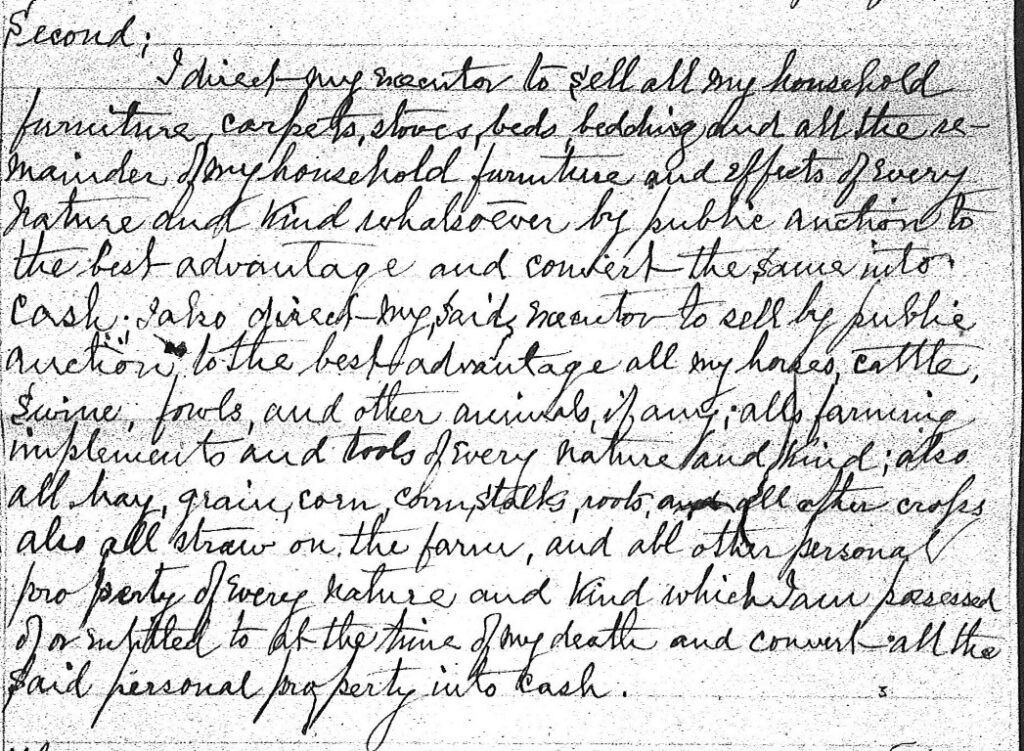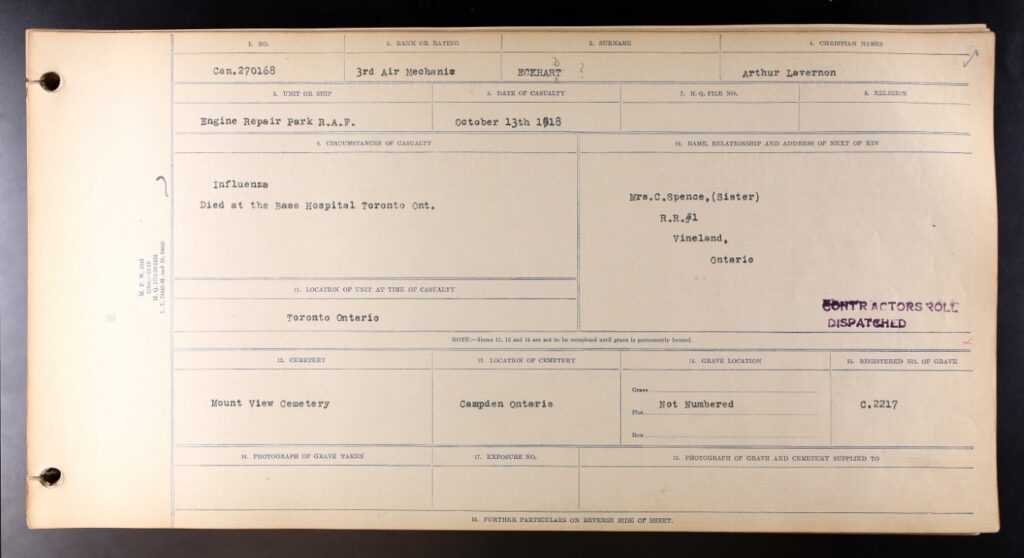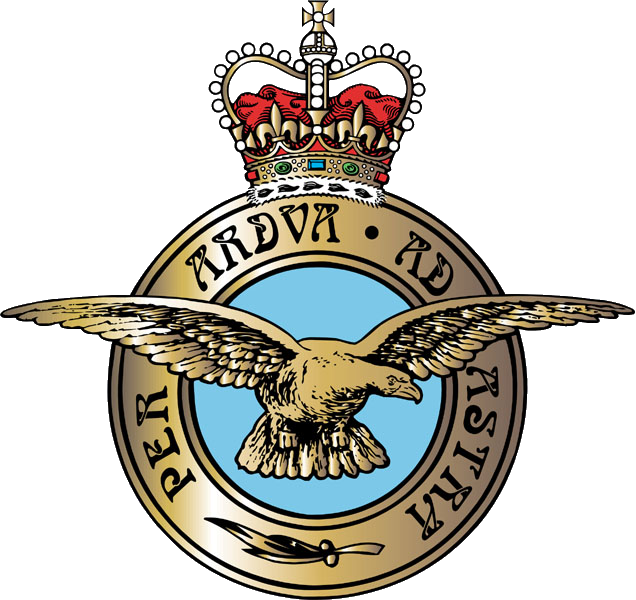The Question “Why”
Of all the questions I can ask as a genealogist, my favourite is, “why?” I asked that question recently about Arthur Lavernon Eckhardt: why did Arthur sell the first Eckhardt homestead in Canada? Over fifty acres on top of the Niagara escarpment near Vineland, he inherited this farm property from his father Byron, who had inherited it from his father Frederick, who was the first of my Eckhardt ancestors to come to Canada from Germany.
My investigations led me to much more than the answer to my question. I learned about Canada’s first airport. I learned how a world-wide tragedy affected our family directly. Most intriguingly, I came to know the brief life story of a member of our family who is likely no longer known to anyone else but me.
Arthur Lavernon Eckhardt would never have been on my research radar, since he springs from a different branch of the Eckhardt tree than I do. But I’ve been tracing the history of the Eckhardt homestead property, and that brought me to him.
Arthur’s father Byron was the younger brother of my great-grandfather, Solomon. The Eckhardt homestead had passed down through Byron, and as Byron’s only son, Arthur inherited the property in 1916 when his father died. Arthur promptly sold it to someone outside the family. This in spite of our original settler Frederick Eckhardt’s directive, spelled out in his will, which left to Byron and “his heirs and assigns forever all my real estate.”

Frederick the patriarch was clearly keen that this land remained in the family. Frederick’s son Byron, though, left instructions in his will to sell everything: the house, all its furniture, the land, the farm implements, all of it, including the two cows, three swine and 35 chickens.

Byon’s son Arthur was not a farmer. He was a civil engineer, and this was my first hint towards an answer to my question. Arthur had even moved away from the Niagara district some five years before his father Byron died. First he worked in Edmonton. Then in June of 1914, he immigrated to the United States to work in Niagara Falls, New York. In both places he was employed as an engineer.
Byron obviously knew that Arthur’s career was not on the land. We don’t know if he was disappointed about this or not, but he certainly laid out very clearly in his will the instructions for the sale of the farm. As for Arthur’s four sisters, only two of them ever married, and although one sister and her husband farmed near to the Eckhardt land, they did not acquire it. Possibly it was beyond their means, or they were content where they were.
So my why question was answered, but Arthur still held a couple of surprises for me.
The Gravestone
When searching to see if I could find out any more about him, I found this picture of Arthur’s gravestone: a full-on Royal Air Force monument, commemorating his service in World War I.

What? The only Eckhardts on record as soldiers of the Great War were my grandfather Albert and his brother Jessie.
I looked closer at the tombstone: air mechanic, it says.
So I double-checked the military files at Library and Archives Canada. No Arthur. Did that mean he didn’t serve overseas? His death record lists his occupation as ‘soldier.’ But wait – it also shows he died at the Base Hospital in Toronto.
So: a soldier, died in Canada, was an air mechanic, was buried with RAF recognition.
It took some further digging to uncover his War Cemetery Record:

This document gave me the story: Arthur was working as an air mechanic at the Engine Repair Park in Toronto. It’s unclear as to how long he’d been doing this work, but regardless, his service there gave him recognition for being a member of the Royal Air Force, and also the rights to that military monument that sits in the Mountainview Cemetery.
Arthur was part of a team of technicians who maintained the airplanes used to train pilots for the Royal Air Force.
The Dawn of Canadian Aviation
At the beginning of the First World War, any Canadian who wanted to become a pilot had to pay for his own training, then make his way to England and fly for the Royal Flying Corps or the Royal Naval Air Service. (Canada did not have its own air force until the 1920s.) The demand for pilots was not being met through those measures, so eventually England appealed to Canada to establish some training schools. The first of these, founded in 1917, was at Camp Long Branch, located on 100 acres of land along Lakeshore Road, just west of today’s Dixie Road in Toronto. This site was the former location of the Curtiss Aeorplanes and Motors Company, which had established Canada’s first airport (“aerodrome”) there in 1915. By July 1917, the flight school and maintenance facility had grown too big for Long Branch, and it relocated to Camp Armour Heights, on a site where today Yonge Street intersects with Highway 401.

By 1918, Camp Armour Heights had evolved into the Special Flight School, training flying instructors for the newly-minted Royal Air Force, a merger of Britain’s two former air services. This is where Arthur would have worked.

Air mechanics were part of a loosely grouped collection of tradesmen attracted to this new aeronautics industry. Some were trained at a school run out of the University of Toronto, and some followed pilots to Europe, fixing ripped fabric wings, stopping fuel leaks and repairing broken wheel struts with whatever they could find at the front. At home, air mechanics supported the flight schools by maintaining the machinery and fleets. In Arthur’s time, the trainers used were Canadian-made Curtiss JN-4 (CAN) bi-planes, known as “Curtiss Jenny Canucks,” to distinguish them from an American version of the plane.

Tragedy Personal and International
Arthur’s death and cemetery records state that he died of pneumonia from influenza on October 12, 1918. This means he succumbed to the famed Spanish Flu, the epidemic that killed 40 million people world-wide, more people than had died in the war itself. Fifty thousand Canadians died from the flu, most of them between the ages of 20 and 40 – the age group that had already been largely destroyed by the war. Arthur was 31 years old.

Soldiers returning from Europe brought the flu with them, spreading out via trains and wagons from several Canadian ports of entry. By October 3, 1918, roughly the date Arthur was admitted, the Base Hospital in Toronto had 500 cases of influenza. By Oct. 9, undertakers couldn’t keep up with the death toll in the city, and by the end of the month, 1,750 Torontonians were dead from flu. Cemeteries were required to stay open for Sunday burials, and the city ordered theatres, movie halls and other public areas closed.
Long Lost and Now Remembered
Like his father and grandfather before him, Arthur left instructions in his will for a monument to be placed at his grave, “bearing a suitable inscription in memory” of him. Thankfully for the genealogists to follow several generations later, this was done. If it hadn’t been, Arthur might have been lost to history. He never married, nor, as mentioned, did two of his sisters. Of the married sisters, one was wed after Arthur’s death and had no children. The other sister did have children, but even including them, all of the people who would have known Arthur, or known of him from his siblings, had died by 1976. I am not aware of any other family historian who has researched this branch of the Eckhardt family.
So once again, a genealogy quest led me down a surprising road, and taught me far more than what I expected to learn. I’ll continue to ask the question why, and many other questions too. Meanwhile, I’ll remember Arthur.

Lee Ann this is an amazing story. Your research uncovered an interesting story and your writing bring the story alive. I really enjoyed reading it.
Oh, such a lovely story – sad that he is lost, but happy to find he is found again. And a good tale too – I learned so much about two major things in Canadian history, the RAF pilot training and the Spanish Flu (can’t believe I had no idea that had happened before I read this piece).
You’re an excellent caretaker of your family’s history, Lee Ann!
What interesting history you have uncovered Lee Ann. Well done!
Wow! What a very interesting story. How exciting for you to learn so much about your Eckhardt side of your family. I really enjoyed reading this story. Thank you for sharing this. You are amazing, my friend.
Awesome! Great story. The first traces of Eckhardt aviation! It all started with Arthur….
You are a great detective Lee Ann
Thank you for sharing this amazing piece of history. No wonder the modern Eckharts are also interested in flying.